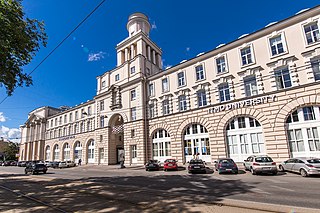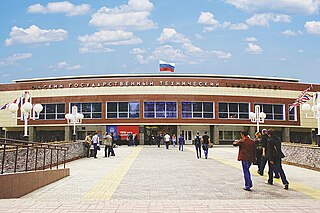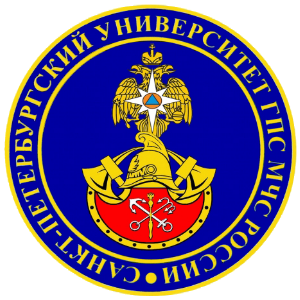
The International Collegiate Programming Contest, known as the ICPC, is an annual multi-tiered competitive programming competition among the universities of the world. Directed by ICPC Executive Director and Baylor Professor William B. Poucher, the ICPC operates autonomous regional contests covering six continents culminating in a global World Finals every year. In 2018, ICPC participation included 52,709 students from 3,233 universities in 110 countries.

ITMO University is a state-supported university in Saint Petersburg and is one of Russia's National Research Universities. ITMO University is one of 15 Russian universities that were selected to participate in Russian Academic Excellence Project 5-100 by the government of the Russian Federation to improve their international standing among the world's research and educational centers.

Saint Petersburg Electrotechnical University "LETI" is a public university. It was founded in 1886 as a Technical College. LETI, as it is popularly called, received the status of a higher education institution in 1899 and became known as Electrotechnical Institute. The University has programs in fields of radio engineering, telecommunications, control processes, computer engineering and IT, electronics, biomedical engineering, management, and linguistics.

Omsk State Technical University (OmSTU) in Omsk, Russia, is an educational institution in the Western Siberian Region. Omsk State Technical University (OmSTU) was established in 1942.

Petrogradsky Island or Petrograd Island is the third-largest island in the Neva River delta in Saint Petersburg, Russia. Along with Zayachy Island, Aptekarsky Island, and Petrovsky Island, it constitutes the Petrogradskaya Side. It is the administrative center of the Petrogradsky District and hosts a number of universities and research centers, as well as cultural, historical, and recreational facilities.

The Bonch-Bruevich Saint Petersburg State University of Telecommunications is a communications university.

The International Institute of Refrigeration (IIR), is an independent intergovernmental science and technology-based organization which promotes knowledge of refrigeration and associated technologies and applications on a global scale that improve quality of life in a cost-effective and environmentally sustainable manner, including:

Vladimir Nikolaevich Vasilyev is a Russian scientist, researcher, professor and rector at ITMO University. Head of the Council of Rectors of St. Petersburg Universities, corresponding member of the Russian Academy of Education, corresponding member of the Russian Academy of Sciences. Since August 6, 2012 – member of the Government of the Russian Federation Expert Council. Honored citizen of St. Petersburg since 2013.
Georgy Mihailovich Kondratiev was a Russian physicist, specialist in thermal measurements.
Sergei Petrovich Mitrofanov was a Soviet and Russian scientist in the field of industrial engineering.
Alexander Panteleimonovich Grammatin was a Soviet and Russian scientist in the field of computational optics, the developer of the theory and author of the first national program for the automated calculation of computer parameters of optical systems by criteria of image quality. He was the Doctor of Technical Sciences, professor, the USSR State Prize laureate (1977) and holder of the Prize of the Council of Ministers of the USSR (1983).
Imperial Commercial College is an educational institution founded in 1772 as part of the Moscow Foundling Home for teaching merchants' children. In 1779 it was named after its founder Prokofi Demidov. In 1800 it was separated from the Home and moved to St. Petersburg. In 1904 it received Imperial status and officially ceased its existence in 1918 but de facto it continued working. In 1931, it served as the foundation for Leningrad Training Mechanics and Technology Refrigeration Plant, which later became the St. Petersburg State University of Refrigeration and Food Processing Technologies.

ITMO University is a state-supported National Research University in Saint Petersburg, Russia. It consists of 4 schools, 17 faculties, and 7 research institutes. As of 2021, the total number of students is above 13,400, with over 2,900 being foreign nationals.

Mikhail Gennadyevich Zingarevich is an entrepreneur and philanthropist, an investor in IT, pulp-and-paper and gold mining industries, property development, a member of the board of directors of the Ilim Group, honorary professor of the Highest School of Technology and Energy at the Saint Petersburg State University for Technology and Design.
Konstantin Ivanovich Strakhovich was a Soviet fluid dynamicist and hydraulic engineer.

The Saint-Petersburg University of the State Fire Service of the EMERCOM of Russia is a state institution for the training of specialists in the Russian Ministry of Emergency Situations. It is currently led by Internal Service Major General Bogdan Gavkalyuk.

Saint Petersburg State University of Industrial Technologies and Design is a public university located in Saint Petersburg, Russia. It was founded in 1930.
Saint Petersburg State Institute of Film and Television is a public university located in Saint Petersburg, Russia. It was founded in 1918.

Saint Petersburg State Agrarian University is a public university located in Saint Petersburg, Russia. It was founded in 1904.















